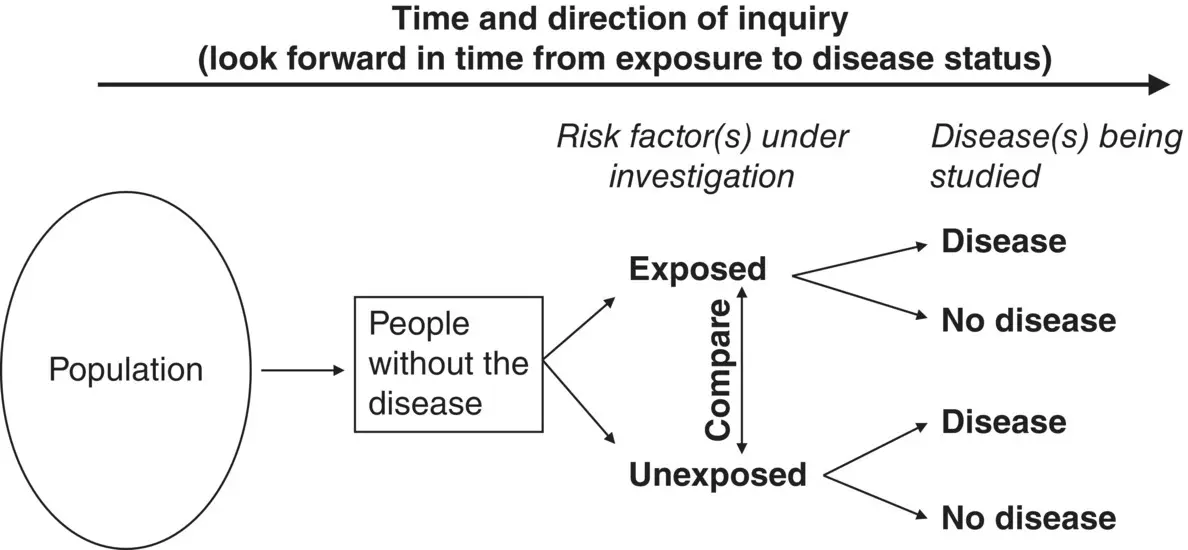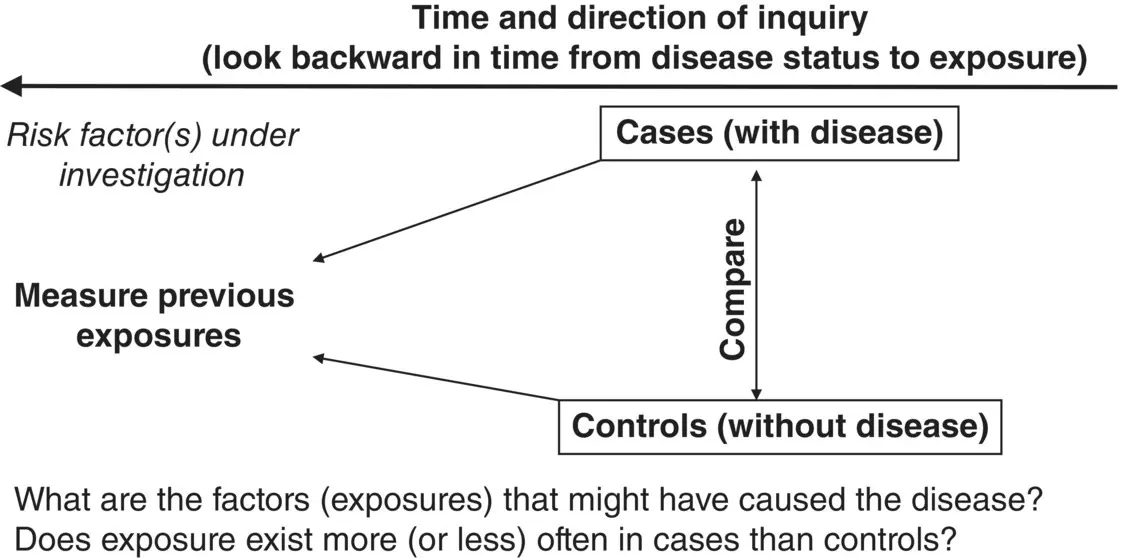Epidemiological studies fall into three categories.
Descriptive studies in epidemiology include ecological studies, cross‐sectional studies, and time trend analysis. They are useful for generating hypotheses. Measurements can be made in individuals at a given point in time (cross‐sectional studies) or accumulated over time in groups of people (ecological studies). They are used to relate measures of exposure and outcome in groups of people that share common characteristics (e.g. vegetarians versus omnivores) or to compare regions or countries. For example, they might compare diet and disease patterns between countries (are heart disease rates lower in countries where people eat lots of oily fish?) or between subgroups (do vegetarians have lower risk of heart disease compared to non‐vegetarians?).
There are two main problems with this type of study. First, there may be other factors that could explain an observed association or changes in the population over time. For example, populations with higher oily fish consumption may be more active or less obese. Second, not everyone in the population or subgroup is exposed at the same level: some individuals in the population may eat lots of oily fish, while others may eat very little. Are the people with low oily fish consumption the ones that have higher rates of heart disease?
These include cohort and case‐control studies. Their primary characteristic is that they relate exposures in individuals (factors that are likely to influence the occurrence of disease or mortality within the population) to outcomes (disease or mortality rates). Analytical studies are usually based on observations relating to large numbers of people in the population (hundreds or thousands). They provide much stronger evidence of diet–disease relationships than descriptive studies. In terms of the Bradford Hill model of causality ( Box 1.4), they provide evidence of temporal association and dose‐response. If blood or urine samples are collected, they may also provide evidence of a plausible physiological mechanism for causation. Detailed descriptions of these designs and their statistical analysis are given in epidemiological texts such as Rothman [9] or Margetts and Nelson [10].
Cohort studies are prospective in nature; they look forward in time, following a group of people who are free from the disease of interest at baseline. Relevant exposures are measured at baseline or time zero. Over time (usually years), the appearance of disease (morbidity), or relevant changes in blood or urine biochemistry, or nutrition‐related mortality, is monitored ( Figure 1.6).
The risk of developing disease (or related outcomes) in the exposed group is compared with the risk of developing disease in the unexposed group. This is known as the Relative Risk.

FIGURE 1.6 Cohort study design.
In nutritional epidemiology, the meanings of ‘Exposed’ and ‘Unexposed’ are different from the meanings in infectious disease or occupational epidemiology. In infectious disease epidemiology, for example, a subject either is or is not exposed to a particular bacterium that can cause illness. In occupational epidemiology, a subject may be classified either as exposed or not exposed to a potential risk factor (e.g. asbestos dust). In nutritional epidemiology, in contrast, variables are usually continuous – no one has a diet that does not contain energy or iron, for example. Subjects are therefore classified into bands of exposure. ‘Exposed’ might mean someone in the top half of the distribution of intake, and ‘Unexposed’ might mean someone in the bottom half. Of course, degrees of exposure may also be ascertained in other spheres of epidemiology, but in nutritional epidemiology it is the norm and forms the basis for most analysis of risk.
In cohort studies, the time sequence of cause and effect is not in question. There may be other factors, however, which over time, explain the apparent associations between the measures at baseline and the outcome measures collected years later (e.g. some individuals may gain more weight than others, or their socio‐economic status at follow‐up may not be the same as it was at baseline). The strength of cohort studies is that if these factors are measured at baseline and again at follow‐up, they can be taken into account in the analysis. The main disadvantage of cohort studies is the length of time it takes to accumulate relevant outcome measures in sufficient numbers of individuals, and the cost of collecting the measurements in hundreds or thousands of individuals over long periods of time.
Case‐control studies , in contrast, start by identifying a group of subjects with a given disease or condition. Controls are subjects who do not have the disease or outcome being investigated. They are matched individually with the cases for age and sex, and often for other variables such as smoking or BMI or income or occupation. The study then looks backward in time to measure exposures that are potentially causal ( Figure 1.7).
Measures of exposure in the past are usually determined by asking cases and controls about their habits in the past using a questionnaire (although sometimes there are records of exposure, for example the type of work someone did, or hospital records of birth weight). The past exposures of the cases are then compared with the past exposures of the controls. The relevant statistical outcome is the Odds Ratio: what are the chances of being exposed and in the disease group compared with being exposed and in the non‐disease group. This is the best estimate of the Relative Risk, which cannot be measured directly in case‐control studies [9, 10].
Case‐control studies are much cheaper to carry out than cohort studies, but accurate measurements of past exposure are often difficult to collect. For example, asking someone what their diet was like 10 or 15 years ago is likely to be heavily influenced by the type of diet they consume now.

FIGURE 1.7 Case‐control study design.
In epidemiology, experimental studies take two forms: clinical trials and community trials. The aim is to compare the impact of the active treatment on the relevant outcomes with the impact of a placebo.
Clinical trials in epidemiology usually take the form of randomized controlled trials. The aim is to see if an intervention to alter exposure results, over time, in a change in outcomes. In epidemiology, clinical trials can involve thousands of subjects followed over many years, whereas studies relating to drug treatments or food interventions relating to changes in blood or urine biochemistry may involve only tens of subjects. The purpose in having such large studies in epidemiology is to be able to generalize to the population with confidence, and to take into account the many confounders (see below) that may operate in the real world.
Researchers usually strive to achieve ‘double blind’ status in their study designs, but in nutritional interventions this may not always be possible. If the intervention involves changing diet, for example, or providing nutritional advice to increase fruit and vegetable consumption, the subject may be aware of the changes and is therefore no longer ‘blind’. Similarly, the researcher involved in administering the changes may be aware of which subjects are in the treatment group and which are in the placebo group. If this is the case, it is important to ensure that the person undertaking the statistical analysis is blinded to the identity of the groups being compared. This can be done through the coding of results for computer analysis so that the comparison is simply between group A and group B. Only at the end of the analysis is the identity of the group revealed. Even here, it may not always be possible to blind the analyst. In that case, the procedures for carrying out the statistical analyses should be described in advance so as to avoid a ‘fishing expedition’, hunting for statistically significant findings.
Читать дальше














